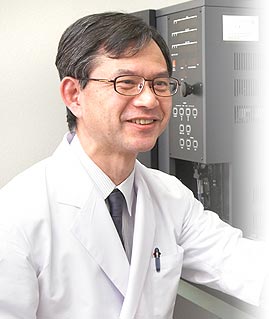
|
Program Overview > Program Members > Seiji, Okada
|

Center for AIDS Research, Professor
Hematology, M.D., Ph.D. Research on Animal Model

 |
 Human Immunodeficiency Virus type 1 (HIV-1) is known to infect a variety of blood cells and influence the human immune and hematopoietic systems. Progress in the anti-HIV-1 therapy so called highly active antiretroviral therapy (HAART) has been successful in controlling HIV-1 infection and drastically improved the prognosis of HIV-1 patients. However, HAART cannot eliminate HIV-1 completely and even well controlled patients still have defects in immune system, which cause the AIDS-related malignancies. As the immune and hematopoietic systems are complex of diverse system, the analysis of the interaction between HIV-1 and these systems are crucial. In this program, we are going to clarify the interaction using in vitro culture system and mouse model especially focused on innate immunity (natural killer cells and macrophages) and hematopoietic stem cells. The goal of our study is to establish the control of HIV-1 infection by immune system. |
|
1. Application of severe immunodeficient mice for AIDS research As HIV-1 infection is complex biological process, animal model is the powerful tool to understand the AIDS pathology. Several attempts are performed to establish the mice with human immune system for 20 years. We developed the new generation of immunodeficient mice which accept the human tissues and generate human immune and hematopoietic systems, and established the three types of model mice. 1) Mice with long-term human immune and hematopoietic system (Humanized mice). 2) Mice with short term human immune system. 3) Mice with functional human NK cell expansion system. These mice provide an opportunity to study the pathogenesis of HIV-1 infection and to develop the new anti-HIV-1 drug and to test the potential vaccine. With the recent advance of anti-HIV-1 drug therapy, the rate of opportunistic infection is decreased but HIV-associated malignancies are still remaining. Especially, AIDS related malignant lymphoma is now one of the leading causes of death among HIV-1 patients1). We established the AIDS related lymphoma (ARL) model mice by transplant the lymphoma cell lines into the immunodeficient mice. These mice are the powerful tools to study the nature of AIDS related lymphoma (ARL) and to establish the new therapy for ARL. We are now focus on the establishment of the target therapy model: 1) Radioimmunotherapy using radioisotope (I-131, I-125, etc) conjugated monoclonal antibodies. 2) Cell therapy using NK cells and monoclonal antibodies. 3) Targeting therapy for NF-kB. Further more, we try to clarify the mechanisms of ARL development using the mice system, which is lead to the prevention of ARL.
2. Hematopoietic stem cells and HIV-1 infection.
3. Innate Immunity and HIV-1 infection.
|
|

|
♦Reference |
|
| 1. | Nagai H, Iwasaki N, Odawara T, and Okada S; Actual status of AIDS-related lymphoma management in Japan. Int J Hematol 87(5):442-443, 2008 |
| 2. | Harada H, Goto Y, Ohno T, Suzu, S, and Okada S; Proliferative activation up-regulates the expression of HIV-1 receptors on NK cells and induces HIV-1 infection of NK cells. Eur J Immunol 37(8): 2148-2155, 2007 |
| 3. | Harada H, Suzu S, Ito T, and Okada S; Selective expansion and engraftment of human CD16+ NK cells in NOD/Scid mice. Eur J Immunol 35(12):3599-3609, 2005 |
 |
 |